
Emily Crum, NOAA Ocean Exploration
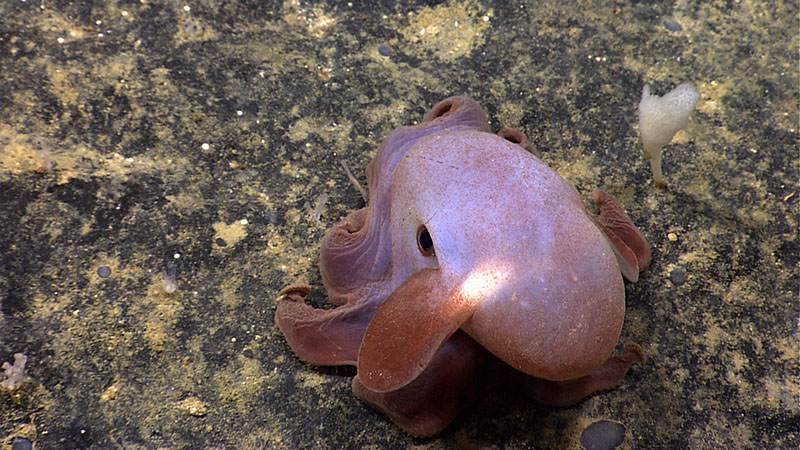
In 2014, we had a great dive exploring the main edifice of the Atlantis II Seamounts group, encountering a wide diversity of life, including this squee-worthy dumbo octopus! Image courtesy of NOAA Ocean Exploration, Our Deepwater Backyard: Exploring Atlantic Canyons and Seamounts 2014. Download largest version (jpg, 1.6 MB).
The 2021 North Atlantic Stepping Stones: New England and Corner Rise Seamounts expedition is underway! While most of our dives during this expedition will occur on seamounts that NOAA Ocean Exploration has not explored yet via NOAA Ship Okeanos Explorer, we will be revisiting a few familiar seamounts within the New England Seamount chain from dives in 2014 and 2019. While these seamounts are BIG and our dives cover only a tiny portion of their slopes, what we saw during previous dives may offer a bit of a preview into what we’ll see on our current expedition.
It will take a little over a day for Okeanos Explorer to reach the first dive site. As the onboard team steams towards this site, collecting valuable mapping data along the way, here are a few highlights from seamounts we explored in the past and may revisit again on this expedition. Enjoy the sneak peak!
Highlights from exploration of the main edifice of the Atlantis II Seamounts in 2014. Video courtesy of NOAA Ocean Exploration, Our Deepwater Backyard: Exploring Atlantic Canyons and Seamounts 2014. Download largest version (mp4, 29.1 MB).
The Atlantis II Seamounts are a group of three individual seamount edifices, or peaks, that lie just outside of the U.S. Exclusive Economic Zone. In 2014, we conducted the first-ever dive on Atlantis II, exploring the northwestern flank of the main edifice of the seamount complex. During the dive, we encountered interesting geology, including pillow lava flows and a carbonate outcrop that appeared to be a drowned reef overrun with lava. Diversity of life was high throughout the dive, and we spotted everything from octocorals, precious corals, and sponges to sea cucumbers, sea stars, crinoids, fish, shrimp, and even a dumbo octopus.
Early in the 2021 North Atlantic Stepping Stones expedition we may once again visit this group of seamounts.
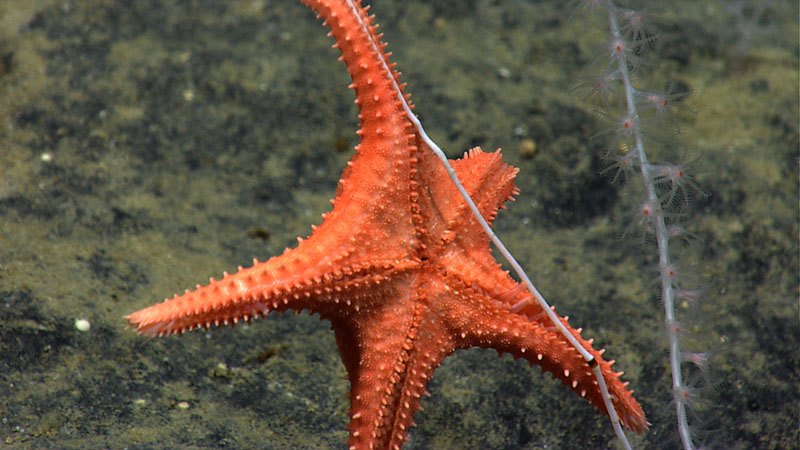
Predation was a common theme during our 2014 expedition. In this image from our Atlantis II Seamounts dive, a sea star feasts on a bamboo coral. Image courtesy of NOAA Ocean Exploration, Our Deepwater Backyard: Exploring Atlantic Canyons and Seamounts 2014. Download largest version (jpg, 1.2 MB).

During the Atlantis II Seamounts dive in 2014, the team encountered this unusual patch of very smooth, almost polished lobate lava tongues covered in a glassy manganese coating. Interestingly, unlike much of the surrounding seafloor, this area was devoid of life. Image courtesy of NOAA Ocean Exploration, Our Deepwater Backyard: Exploring Atlantic Canyons and Seamounts 2014. Download largest version (jpg, 1.5 MB).
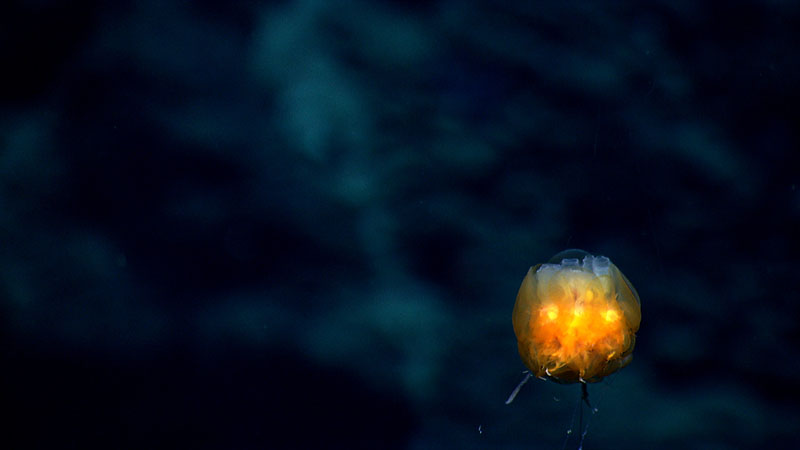
Even though they are rare, we were lucky enough to see dandelion siphonophores on three dives during the 2014 expedition, including this one imaged during the Atlantis II Seamounts dive. Image courtesy of NOAA Ocean Exploration, Our Deepwater Backyard: Exploring Atlantic Canyons and Seamounts 2014. Download largest version (jpg, 919 KB).
This video provides an overview of our 2014 dive on Gosnold Seamount. Video courtesy of NOAA Ocean Exploration, Our Deepwater Backyard: Exploring Atlantic Canyons and Seamounts 2014. Download largest version (mp4, 24.1 MB).
Rising nearly 3,400 meters (2.1 miles) off the seafloor, Gosnold Seamount is a large, elongated guyot similar in size and shape to the main edifice of the nearby Atlantis II Seamounts. In 2014, we conducted the first-ever exploration of this seamount, traversing its northern flank and discovering an incredible landscape of deep-sea corals as well as a diversity of sponges and fish, crinoids, coral rubble, sea cucumbers, shrimp, sea stars, urchins, sea spiders, and more! On the geology front, most of the seafloor throughout the dive was jumbled lava sheet flows with small, irregular lobes. The flows were covered in a light dusting of sediment and large amounts of biological debris and overgrowth.
Exploration of Gosnold may be on the docket once again in 2021, and if it is anything like our 2014 dive, it’s not likely to disappoint!
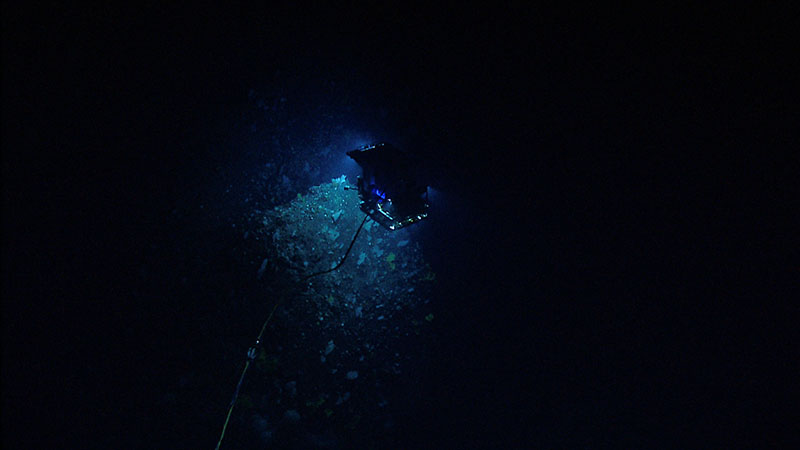
Remotely operated vehicle Deep Discoverer descends on a seafloor densely populated with a diversity of deep-sea corals and sponges during our 2014 dive at Gosnold Seamount. Image courtesy of NOAA Ocean Exploration, Our Deepwater Backyard: Exploring Atlantic Canyons and Seamounts 2014. Download largest version (jpg, 1.1 MB).
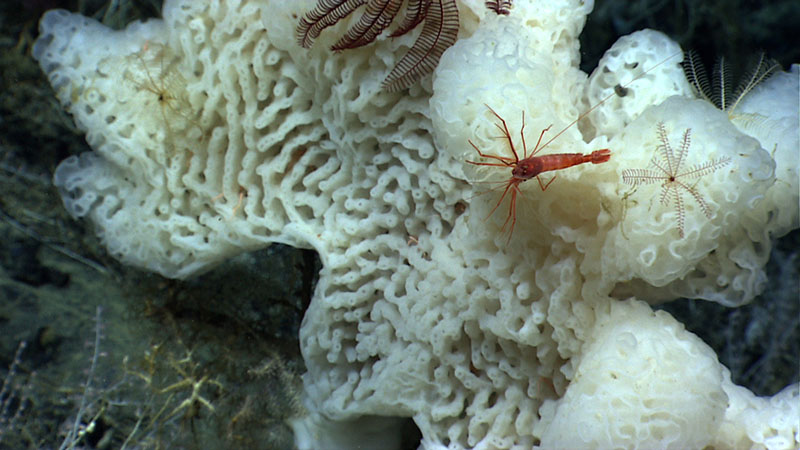
This benthic shrimp and several crinoids were seen sitting on a beautiful glass sponge during the 2014 dive on Gosnold Seamount. In addition to providing homes for the animals we could see, the folds, nooks, and crannies of the sponge also likely provided homes for animals such as amphipods, other crustaceans, and worms. Image courtesy of NOAA Ocean Exploration, Our Deepwater Backyard: Exploring Atlantic Canyons and Seamounts 2014. Download largest version (jpg, 1.2 MB).
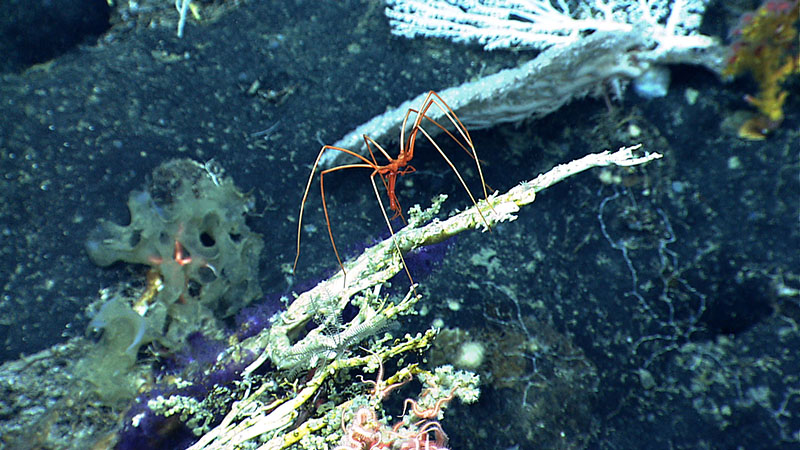
In this single, colorful image from our 2014 Gosnold Seamount dive, you can see a (orange) sea spider, a (white) Corallium coral colony, a (purple) octocoral, and (pink) brittle stars. Image courtesy of NOAA Ocean Exploration, Our Deepwater Backyard: Exploring Atlantic Canyons and Seamounts 2014. Download largest version (jpg, 1.5 MB).
Highlights from the 2014 exploration of Kelvin Seamount. Video courtesy of NOAA Ocean Exploration, Our Deepwater Backyard: Exploring Atlantic Canyons and Seamounts 2014. Download largest version (mp4, 47.7 MB).
Kelvin Seamount is a large (3,300-meter/2-mile tall), flat-topped guyot with evidence of massive failure and collapse of large parts of its edifice in some locations. In 2014, we explored an unusual bulls-eye or dome-shaped feature rising from the otherwise flat summit of the seamount. At the beginning of the dive, we encountered primarily uniform, rippled and sandy seafloor that was home to animals such as sea cucumbers, sea stars, anemones, urchins, and a few corals. As the dive continued up the slope of the feature, the underlying geology changed to hard rock lobate sheet flows with a high diversity, but low abundance, of corals. During this part of the dive, we also saw crinoids, a diversity of sponges, shrimp, fish, sea spiders, crabs, and sea stars.
We may have the opportunity to dive on Kelvin Seamount in 2021 — keep an eye out for more info!
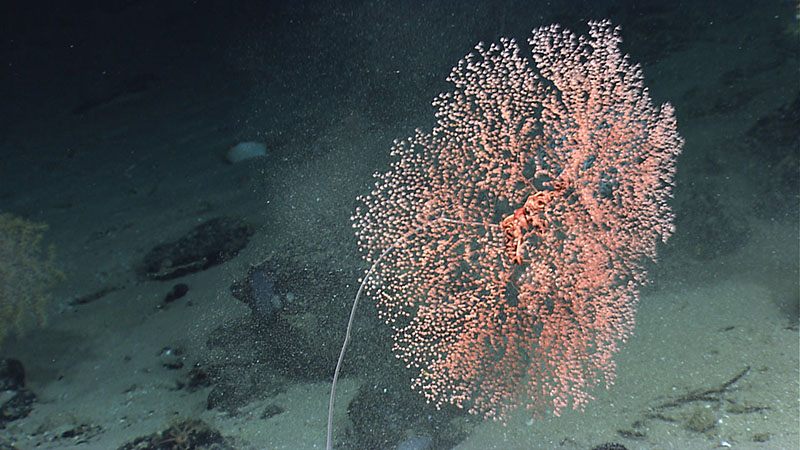
The delicate pink polyps of this octocoral provide a home for a brittle star, wrapped in the middle of the coral’s branches. Seen while exploring Kelvin Seamount in 2014. Image courtesy of NOAA Ocean Exploration, Our Deepwater Backyard: Exploring Atlantic Canyons and Seamounts 2014. Download largest version (jpg, 1.3 MB).
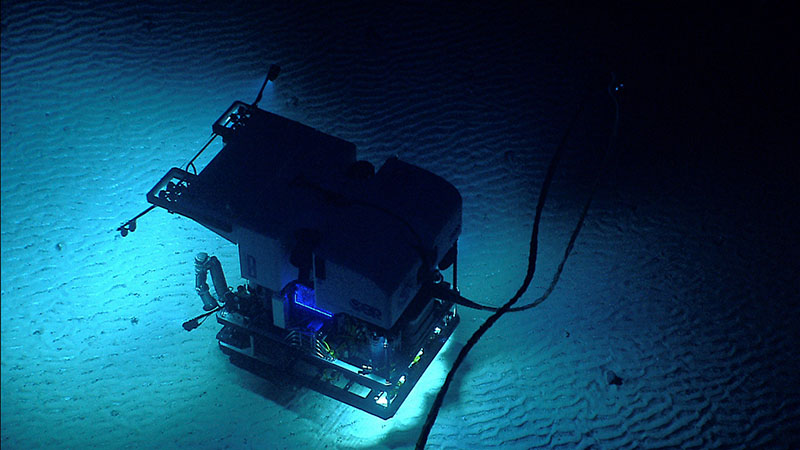
Remotely operated vehicle Deep Discoverer moves across a field of bedforms or ripples on a flat area of Kelvin Seamount during our 2014 dive. Geologists and oceanographers can learn quite a bit about the current conditions of an area by studying the size and shape of ripples such as these. Image courtesy of NOAA Ocean Exploration, Our Deepwater Backyard: Exploring Atlantic Canyons and Seamounts 2014. Download largest version (jpg, 1.3 MB).
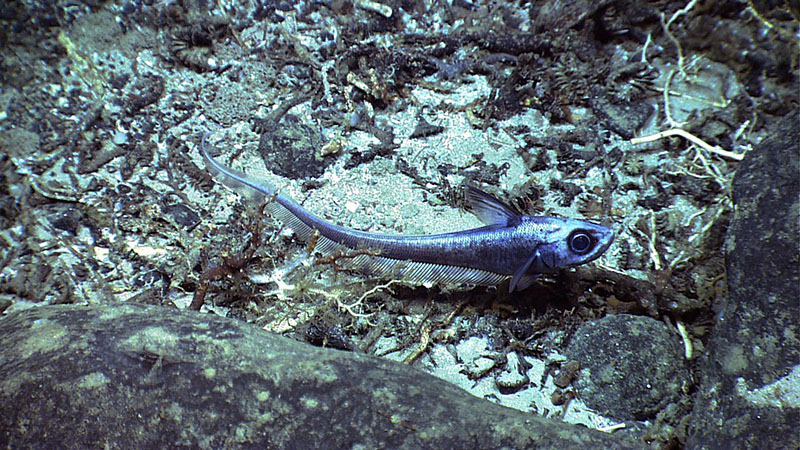
During our 2014 dive on Kelvin Seamount, we encountered only a handful of fish species, including this small grenadier in the genus Macrourus. Image courtesy of NOAA Ocean Exploration, Our Deepwater Backyard: Exploring Atlantic Canyons and Seamounts 2014. Download largest version (jpg, 1.9 MB).
Some of the highlights from our 2014 dive on Retriever Seamount. Video courtesy of NOAA Ocean Exploration, Our Deepwater Backyard: Exploring Atlantic Canyons and Seamounts 2014. Download largest version (mp4, 49.4 MB).
Retriever Seamount is one of four seamounts located within the Northeast Canyons and Seamounts Marine National Monument. We may get to explore it again during the 2021 North Atlantic Stepping Stones expedition. What might we see?
During our 2014 Retriever Seamount exploration, we encountered some of the highest diversity of corals seen throughout the entire expedition. Throughout the dive, much of the seafloor was covered with a layer of sediment that was 50 centimeters (20 inches) thick or more and home to animals such as sea pens, cup corals, and brittle stars. Occasionally, however, we encountered ferromanganese-encrusted boulders or rock outcrops that provided hard surfaces on which animals could settle and attach. It was on these surfaces where we saw areas of highest faunal diversity, with plenty of corals, sponges, and anemones. The highlight of the dive was a large outcrop with a high diversity of corals that included stony corals, octocorals, precious corals, black corals, and bamboo corals. Several of these colonies were juveniles, showing that this is an area of active coral recruitment. Our 2019 exploration yielded similar results, with a stunning array of corals and sponges adorning most areas explored during the Deep Connections 2019 expedition dive.

The area we surveyed on Retriever Seamount in 2014 had a high diversity of sponges, including this one with several crinoids using the sponge to elevate their positions in the water column. Image courtesy of NOAA Ocean Exploration, Our Deepwater Backyard: Exploring Atlantic Canyons and Seamounts 2014. Download largest version (jpg, 1.5 MB).
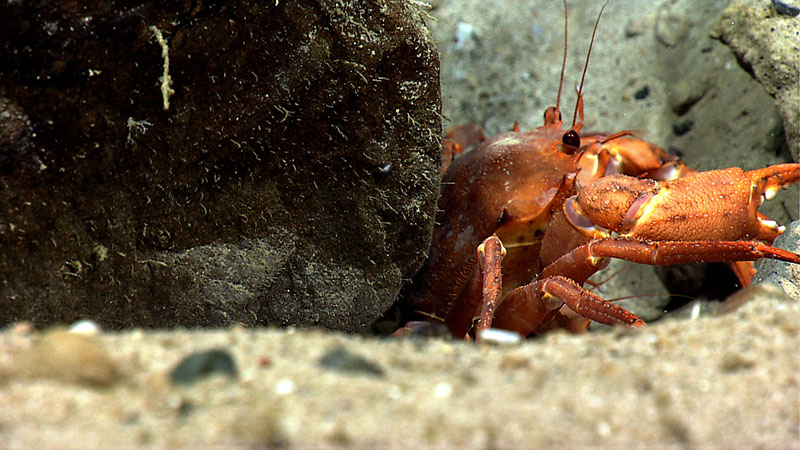
We caught a glimpse of this red crab hiding against a ferromanganese-encrusted boulder during 2014 exploration of Retriever Seamount. Image courtesy of NOAA Ocean Exploration, Our Deepwater Backyard: Exploring Atlantic Canyons and Seamounts 2014. Download largest version (jpg, 1.5 MB).
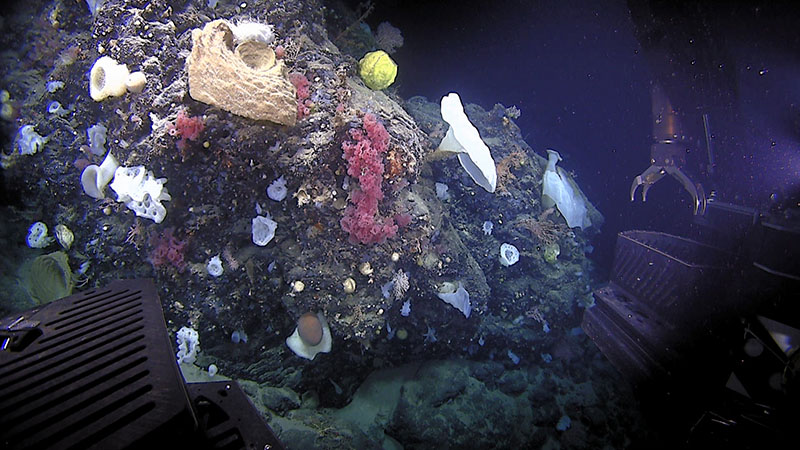
A large diversity of corals and sponges were seen throughout the Deep Connections 2019 expedition dive on Retriever Seamount. Image courtesy of NOAA Ocean Exploration, NOAA Ocean Exploration, Deep Connections 2019. Download largest version (jpg, 1.2 MB).
Our first dive is scheduled to take place on July 2. Every dive is an adventure, and we never know exactly what we’ll find — but that’s part of the value and excitement of exploration. So be sure to tune in throughout the month of July as we unlock the mysteries of these underwater mountains!
Published June 30, 2021